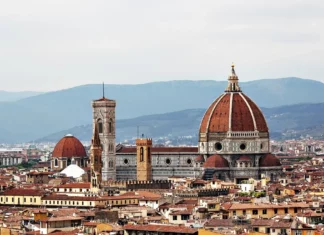The current Ponte Vecchio dates back to 1345. The bridge is an integral part of the history of the city and has undergone various changes throughout the Middle Ages and Renaissance, after which we can see it today in all its splendour.
Ponte Vecchio (literally “Old Bridge”) is indeed old. The Etruscans were the first to identify a ford in the river Arno, in the 7th century before Christ, and later the Roman founders of the village of “Florentia” built a wood and stone bridge there.
The particular and never-seen-before architectural structure of the bridge – made of segmental arches – gives it stability and an unmistakable profile. From the very beginning it housed shops and porticos on both sides facing the centre. Then in 1565, at the behest of of Cosimo de’ Medici, the Vasari Corridor – a strategic passageway – was built atop the higher section of the bridge to connect the administrative buildings to his private residence so as not to expose the sovereign and his heirs to any danger.
Due to the nature of the Vasari Corridor, this area changed its face during the Renaissance era. The traditional shops of greengrocers, butchers and fishmongers were collectively evicted: goldsmiths’ and jewellers’ shops were considered a more appropriate choice for the sovereign, and they have continued their work here ever since, much for the pleasure of tourists.
For more than four hundred years, Ponte Vecchio has therefore been inhabited by artisans creating admirable gold and silver pieces. To this day, this remains the main commercial business of the neighbourhood, also rich in other luxury trades, to name one: artisan leather goods.
Whether you go to admire its structure or to buy a souvenir, Ponte Vecchio is an unmissable stop!



